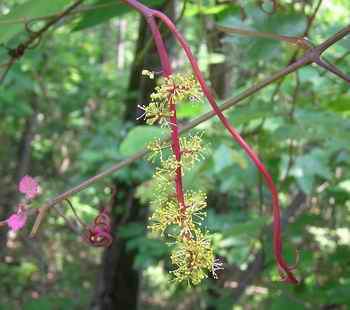|
Return to Hiker's Notebook Home Page
Common Name: Fox Grape - The word grape is from the Frankish graper, to pick grapes which came from Old High German krapfo meaning hook; the fruit was named for the hook used to harvest it. Grape replaced the original English name winberige (wine berry). The adjectival term refers to the consumption of the fruit by foxes. Scientific Name: Vitis labrusca - The generic name derives from the Latin verb vicre, to bind or twist, vitis meaning "that which winds"; labrusca is Latin for wild grape vine.
There are between 19 and 35 recognized species of native North American grapes according to a variety of credible sources. Many of the early naturalists tried to establish appropriate speciation; however, their independent efforts resulted in a profusion of species, subspecies and varieties. Among the species, Vitis labrusca is one of the most prominent and it is widely recognized. The common names are even more heterogeneous, as local usage and dialect are parochial by nature. The fox grape is known by about 30 names including black grape, buck grape, frost grape, plum grape, skunk grape and swamp grape.
Vitis labrusca grows in cooler climate conditions such as those of the northeastern region of North America and ranges from Maine to South Carolina and west to the Appalachian Mountains. It is probably the grape sighted by Norse explorers from Greenland when they named the maritime area of Canada Vinland for its grape vines. The species was domesticated by the early colonists when imported European grapes (V. vinifera) would not grow in the colder climate. The Concord grape is a cultivar of V. labrusca that was first hybridized in Concord, Massachusetts in 1843. It is still the predominant cultivar and is used for jelly, jam and grape juice, Welch's being the most popular brand name. It is also used in New York to make sweet and fruity wines; Cold Duck is a noted sparkling wine made from the Concord cultivar.
The hardiness of the North American grapes such as V. labrusca is manifest in the resistance of its rootstock to diseases. In the 1860's, the grape phylloxera, Dactylosphaera vitifolii, was accidentally introduced to Europe from North America, probably on an infected grape hybrid. This aphid, commonly but incorrectly known as the grape root louse, was responsible for the most notable disaster ever to befall the fruit industry. Phylloxera nymphs feed on grape leaves and then drop to the ground where they destroy the root system. When the winged adult emerges in the fall, it flies to new vines to lay eggs thereby spreading the infestation. By 1868, one third of the vineyards in France had been devastated. Armed with the knowledge that North American grape species had coexisted with the aphid for centuries and must therefore be resistant, horticulturalists began a long process of seeking a resistant grape rootstock on which to graft V. vinifera. Their initial choices, though resistant to the phylloxera, could not tolerate the high PH (basic) soils of France. Ultimately, a number of hybrids were identified and the French wine industry was saved by American roots.
V. vinifera was one of the first species to be domesticated for three reasons: it is native to the Caspian Sea area near Mesopotamia where agriculture has its roots; it stores well for sustenance between growing seasons; and it is easily propagated by either cuttings or seeds. Seed propagation is viable because the flowers of most grapes are perfect (having male stamens and female pistils in the same flower) and self-fertile so that they are self-pollinating, a process that is normally accomplished by the wind. Cross-pollinating fruits like the apple yield highly variable fruits.
Grapes have been used to make wine for millennia, almost certainly due to the serendipitous nature of the fruit. Grapes are high in sugar and fungal yeasts grow naturally on their skins. If grapes are stored in a closed vessel (such as a lidded clay pot) from which oxygen is excluded but carbon dioxide is allowed to escape, all of the conditions necessary and sufficient for fermentation are present. The Greek Dionysus (Roman Bacchus) was the god of wine, and the Oschophoria was his festival. It was widely believed that the drunken state was evidence of the influence of the gods and that the intoxicant was imbued with clairvoyance. This mystical association of wine carried over to some religions, where wine is considered to be symbolic of the blood of life.
In 1996, scientists discovered that grapes contain resveratrol, a chemical known to inhibit tumors and to have anti-inflammatory properties. It is currently hypothesized that red grape consumption (a glass of red wine a day) will reduce the incidence of colon cancer and heart disease, while lowering LDL and raising HDL cholesterol. |

